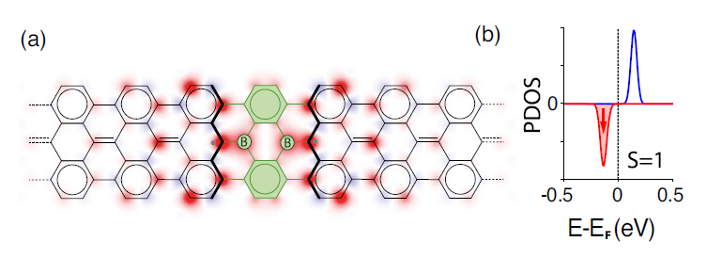Magnetism in graphene nanoribbons induced by a pair of boron atoms
Graphene nanoribbons (GNRs), are strips of graphene with ultra-thin width (<50 nm). Graphene ribbons, introduced as a theoretical model by Mitsutaka Fujita and coauthors to examine the edge and nanoscale size effect in graphene, have emerged as a promising material for nano electronics, as they combine many of the extraordinary properties of graphene with a high tunability of their electronic band structure.
Chemical doping of GNRs has been achieved through the modification of the molecular precursors to either incorporate substitutional heteroatoms in the carbon backbone or by adding functional groups at the edges. In simplest scenarios, the effect of attached chemical groups can be described as an electrostatic gating of the native band structure. Now, a team of researchers shows 1 that inserting a pair of boron atoms in the carbon lattice of graphene nanoribbons (GNRs) can also enable a magnetic ground state.

In spite of being a diamagnetic material, graphene can develop a special class of magnetism via the polarization of its π-electron cloud. Such π paramagnetism is less localized than the more conventional d or f magnetism, and can interact over longer distances. Magnetic graphene nanostructures allows a customization of interacting spin systems for applications in quantum spintronic devices.
The recent development of on-surface synthesis has open a path to graphene π paramagnetism. In this technique, nanoscale graphene flakes with customized shape and composition are fabricated over a metal substrate through the steered reactions between designed organic precursors. Scanning tunnelling spectroscopy experiments have found solid evidence of magnetism in flakes with zigzag edges. But they are difficult to fabricate and highly reactive.
Substituting one carbon atom of the graphene lattice by heteratoms is a potential route to induce magnetism. A representative case is the doping of graphene with substitutional boron atoms, because it can be idealized as the removal of one electron from the conjugated bipartite lattice. However, boron atoms do not induce any spin imbalance in the graphene lattice, but simply behave as a point potential. A prerequisite for the emergence of π paramagnetism is that the point defect also causes a sufficiently large rupture of the conjugated electron system.
Magnetism can also be induced away from physical GNR zigzag edges through atomically precise engineering topological defects in its interior. This is what the researchers have now shown inserting a pair of substitutional boron atom in the carbon backbone, thus breaking the conjugation of their topological bands and building two spin-polarized boundary states around them.
Density Functional Theory simulations reveal that a pair of substitutional boron atoms in a 7-carbon-atom wide armchair GNR can build up a net magnetic moment: boron pairs induce a spin 1, which is modified by tuning the spacing between pairs. This contrasts with the complete absence of magnetism when the pair is inserted in extended graphene. Experimentally, the spin state was detected in electrical transport measurements through boron-substituted GNRs suspended between the tip and the sample of a scanning tunnelling microscope.
These results support that spins survive in free-standing GNRs and can form S = 1 spin chains for low concentrations. What is more, the stronger sensitivity of substitutional boron heteroatoms to chemical bonding endows these systems with ideal properties to manipulate complex spin states in chains.
Author: César Tomé López is a science writer and the editor of Mapping Ignorance.
Disclaimer: Parts of this article might have been copied verbatim or almost verbatim from the referenced research paper.
References
- Niklas Friedrich, Pedro Brandimarte, Jingcheng Li, Shohei Saito, Shigehiro Yamaguchi, Iago Pozo, Diego Peña, Thomas Frederiksen, Aran Garcia-Lekue, Daniel Sánchez-Portal, and José Ignacio Pascual (2020) Magnetism of Topological Boundary States Induced by Boron Substitution in Graphene Nanoribbons Phys. Rev. Lett. doi: 10.1103/PhysRevLett.125.146801 ↩